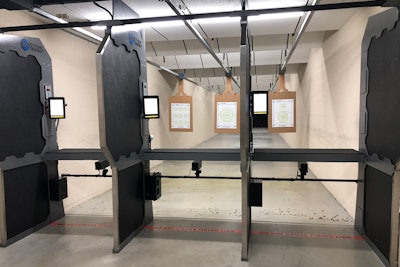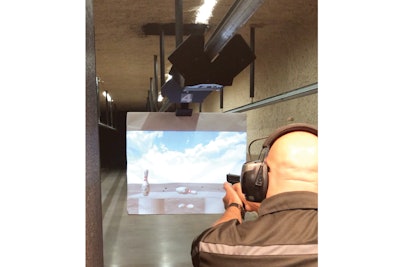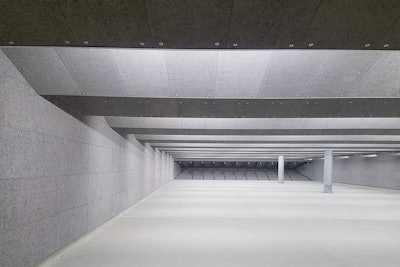 Targetscope’s X-Shot uses a camera below the shooting bench, a touchscreen monitor, and a PC box that mounts to the shooting stall or ceiling to give officers immediate feedback.Photo: Targetscope
Targetscope’s X-Shot uses a camera below the shooting bench, a touchscreen monitor, and a PC box that mounts to the shooting stall or ceiling to give officers immediate feedback.Photo: Targetscope
Live-fire training on shooting ranges is essential for firearms qualification, sure. But more importantly it allows officers to at least maintain and at best improve their firearms skills.
Today’s ranges still cover the basics, but advanced technology can enhance training in ways that weren’t possible before. If your facilities haven’t been revamped in a while, here are some tips for where to start.
Determine Goals
As with most things, it’s best to have an idea of what you plan to accomplish at the get go. Is the reason for updating your range an issue of compliance for safety reasons or new training standards? Or are you looking to add equipment that will allow instructors to teach additional skills?
“If it’s just to qualify an officer, that’s much different than a more aggressive approach to training,” says Steve Wiley, co-owner and co-founder of Targetscope. “Do you want the officer to be able to complete walking drills, timed drills, and particular scenario drills?” By establishing your goals first, you’ll have a framework from which to research companies and find the products and services to meet your needs.
Recommendations from other agencies can also be helpful. Just be sure to keep in mind any differences in their needs and yours, and be sure to do your own homework.
Enhanced Equipment
If you’re looking for a quick refresh, new targets could be the answer. They’re relatively inexpensive and can be used in a variety of settings.
Companies like Qualification Targets sell standard targets available in hundreds of designs on different materials—paper, cardboard, steel, plastic—as well as custom targets. If an agency wants officers to focus on a particular aspect of marksmanship, a custom target that highlights a specific zone of the target could help them meet their training goals. A one-time fee is required to create a new custom target, but there are discounts available based on volume.
If you desire a more comprehensive system to enhance firearms training, there are many high-tech solutions available.
Targetscope’s X-Target system was designed to provide instant feedback with useful metrics such as grouping size, split times, and shot counts so more time can be spent shooting and improving marksmanship instead of scoring the target. A touchscreen monitor set up behind the firing line in each shooting lane displays the feedback. Officers can also use targeted training programs to improve specific areas.
“It benefits law enforcement in that they can get the most bang for their buck when it comes to the time spent training,” says Wiley. “You can still have the lanes and benches and shoot at paper targets on a standard retriever. But the real benefit is from the instant feedback you can get on a screen. They can quickly see the areas for improvement.”
Another option for updating traditional firing lanes with technology is Meggitt’s XWT ProImage projected target system. It lets you use still and video image projection on paper instead of traditional market paper targets, offering more flexibility. “The combination of virtual and live fire, including use of Meggitt’s Live-Fire Screen in indoor ranges, as well as our mobile RoadRange and customizable SHOTT House, enables seamless training from virtual only through live-fire,” says Jon Read, director of live-fire systems at Meggitt Training Systems.
While not technically part of a shooting range, training simulators can be used for marksmanship training to supplement live fire. For example, Ti Training offers its Firing Line system, while Virtra offers the V-ST Pro.
Technology Upgrades
If you’re going to be installing more technologically advanced equipment, make sure your facility can support it. You might need to upgrade the electrical system and add or improve wireless connectivity to get the most out of your new additions.
“For our system, you just need a standard 120-volt outlet,” says Targetscope’s Wiley. “But I’ve been at some ranges where you need an extension cord to get something rigged up.” If your range fits this description, you should really upgrade your electrical to maximize use of current technology and ensure that using it will be safe for everyone at the range. “Making sure each lane has access to outlets is important,” Wiley says.
 Installing Meggitt Training Systems’ XWT ProImage projected target system allows you to use still and video image projection on paper at the range instead of traditional paper targets.Photo: Meggitt Training Systems
Installing Meggitt Training Systems’ XWT ProImage projected target system allows you to use still and video image projection on paper at the range instead of traditional paper targets.Photo: Meggitt Training Systems
Lighting is another consideration when rethinking a training space. It can allow for a better experience when using projection technology if you can make the room darker. And if you’d like to conduct low-light training on the range, you’ll need the ability to create the right conditions.
“An inherent advantage of indoor ranges is the ability to control lighting,” says Read. “Today’s increasingly sophisticated lighting controls should be part of range specifications. This will enable usage of a variety of Meggitt equipment, enhancing the value of an indoor range.”
If you’re able to add large rolling doors to allow actual squad cars to enter the range, you’ll increase officers’ ability to train in dynamic, realistic scenarios indoors. To do this, you’ll need to take into consideration how this might affect placement of the systems you’ll be installing, and the technology needed to operate them.
Safety Compliance
Sometimes agencies upgrade their training facilities to add things they want. Unfortunately, there are times when they’re required to make changes to meet safety regulations. This can happen because standards change, but also when the right safety elements fail to be incorporated into a range’s initial design.
“There are lots of things architects and engineers need to know,” says Bill Bergiadis, CEO of Troy Acoustics. He says this includes the ins and outs of acoustics, ballistic containment, ventilation, security, and access and egress.
Bergiadis likes to be included in the planning stages of a new shooting range, but he says he and his company are often contacted only after neighbors make noise complaints or instructors recognize that the noise within the facility is too loud for officers to train in without suffering hearing loss.
With development creep, it’s becoming more common for ranges that were located in the middle of nowhere when they were built decades ago to all of a sudden have neighbors in new housing developments close enough to complain about the noise.
A municipality might think about moving the shooting range to fix this problem, but that would require cleaning lead from the ground first, as well as finding a new location and building there. Bergiadis says it’s cheaper to mitigate the noise level at the source with canopies and ballistically contained walls that are acoustically treated and properly positioned to assist in the mitigation of sound traveling.
 It’s important that shooting ranges meet all safety requirements or they could get shut down. This range completed by Troy Acoustics now contains the necessary improvements for proper noise control.Photo: Troy Acoustics
It’s important that shooting ranges meet all safety requirements or they could get shut down. This range completed by Troy Acoustics now contains the necessary improvements for proper noise control.Photo: Troy Acoustics
Overhead canopies installed on outdoor ranges to mitigate noise can also provide additional benefits. They shield officers and instructors from the heat of the sun and from rain and snow, extending the amount of time that can be spent on the range.
A newer benefit is protection from drones. Bergiadis says more agencies have expressed interest in canopies for this reason. They don’t want people using drones to spy on officers’ tactics, or their “motions and methods,” to gain an advantage in an active shooter incident, for example.
Ventilation is another safety concern for ranges. Shortcuts might have been taken because the people who installed the equipment weren’t knowledgeable enough or because of a desire to meet budget. “Ventilation is huge,” Bergiadis says. The airflow needs to move 75 feet per minute downrange, or it becomes hazardous for the shooters and instructors due to lead being inhaled and entering the blood stream. So if that is a problem with your range, take the necessary actions to correct it immediately.
Ballistic containment is of course always a top priority. It should go without saying that a range should be designed so bullets cannot escape the facility. But design flaws do happen, and there are ways to correct them. “There was a range a few years back, and neighbors kept finding metal fragments in their backyards,” shares Bergiadis. “They shut down the facility until they fixed it.”
When it comes to appropriate range access and egress to maintain safety, again, it should be simple. First of all, don’t position the entrance at the bullet trap. “Most architects understand that, but sometimes you’ll see it,” Bergiadis says. “You need to come in through a set of doors behind the firing line and then walk down inside the range.
However you decide to upgrade your range, it’s prudent to set it up as best you can to benefit officers for years to come.
Thank you to Meggitt Training Systems, Qualification Targets, Targetscope, and Troy Acoustics for their assistance in producing this article.
Melanie Basich is managing editor of POLICE and PoliceMag.com.















